I have practiced small animal medicine for fifteen years, and during that time, I received many questions about cats and feeding them milk.
Cats are funny animals and have different preferences for food than we do. Studies have shown that they do not have the taste receptor for sweets on their tongues. However, they do like milk!
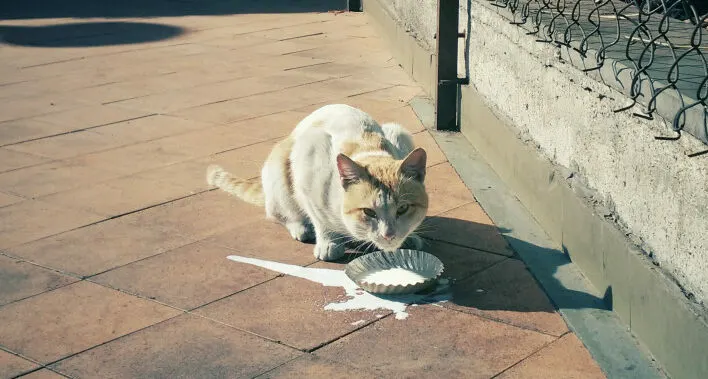 Cats like milk because it is full of fats and proteins that attract carnivores. The taste of milk is mildly sweet but not enough to dissuade a cat from drinking it.
Cats like milk because it is full of fats and proteins that attract carnivores. The taste of milk is mildly sweet but not enough to dissuade a cat from drinking it.
The texture is easy to lap up, and few cats will turn up their noses at the left-over milk in your cereal bowl.
The question concerning milk and cats usually concerns whether milk is good for cats to drink. This question can have a few different answers.
Lactose Intolerance In Cats
As Kittens
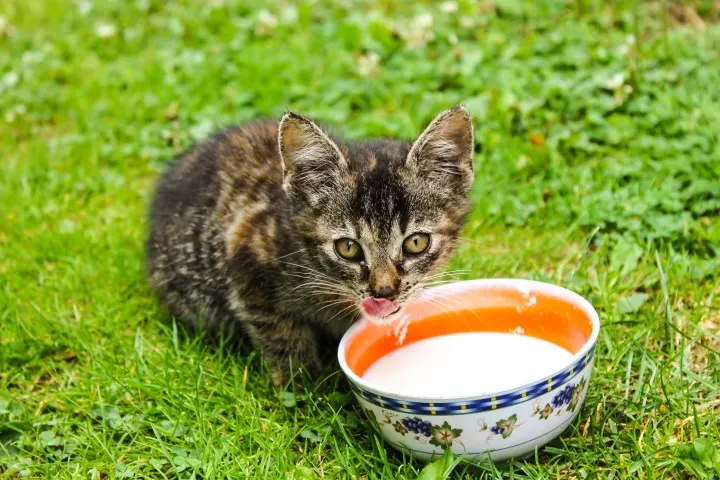 All cats drink milk when they are first born as kittens. Milk from the mother cat is the perfect food to nourish the young kitten and help it to grow big, strong, and healthy.
All cats drink milk when they are first born as kittens. Milk from the mother cat is the perfect food to nourish the young kitten and help it to grow big, strong, and healthy.
When kittens are young, they possess an enzyme in their gastrointestinal tract called lactase. This enzyme’s job is to break down the sugar, lactose, that is contained in milk.
Once broken down from complex sugars into simple sugars, the young kitten can digest the milk and use the sugars for energy.
As kittens grow and begin to eat solid food, they lose the ability to digest milk properly. This is due to the loss of the enzyme lactase.
This loss may not happen all at once, but by adulthood, most cats are what we consider in humans to be “lactose intolerant.”
When Adult Cats Drink Milk
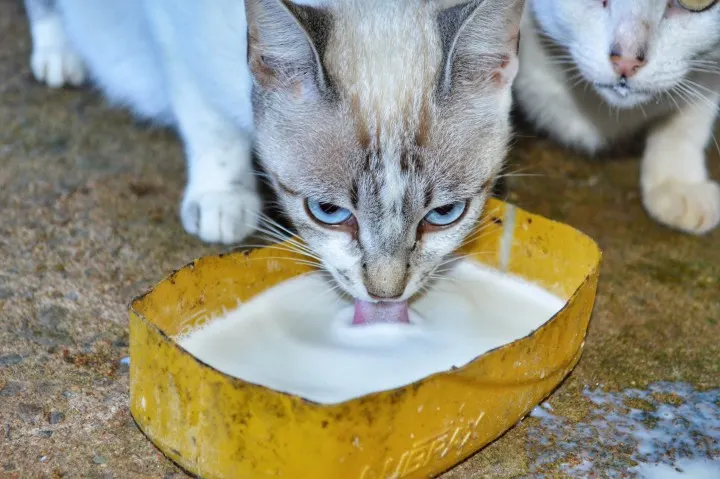 When full-grown cats ingest milk, their lack of the enzyme lactase leads to lactose intolerance and results in stomach pain, bloating, gas, and occasionally, diarrhea.
When full-grown cats ingest milk, their lack of the enzyme lactase leads to lactose intolerance and results in stomach pain, bloating, gas, and occasionally, diarrhea.
These gastrointestinal signs are due to the digestive system’s inability to digest the lactose sugar in the milk.
Small amounts of milk may not cause this issue, as gastrointestinal distress is most commonly dose-dependent. This means that the more lactose a cat ingests, the sicker the cat is likely to become.
Other Dairy Products
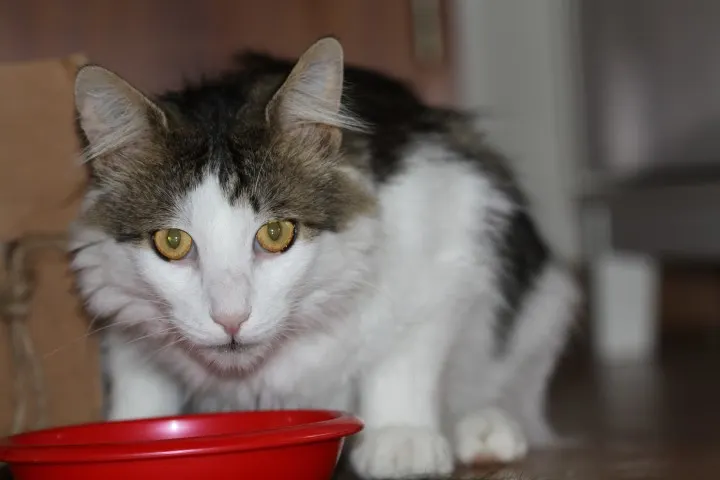 Many pet owners witness their cat feeling under the weather after drinking milk or seeing the evidence in the litter box, and wonder if other dairy products might make a better snack.
Many pet owners witness their cat feeling under the weather after drinking milk or seeing the evidence in the litter box, and wonder if other dairy products might make a better snack.
Cats definitely have a taste for cheese, ice cream, and yogurt in much the same way as they enjoy milk.
Sadly, ice cream tends to have the same effect on a cat’s stomach as milk does, as it still contains high levels of lactose.
Allowing your cat to lick the spoon of your ice cream sundae may be acceptable as it is a tiny amount of ice cream.
Cheese and yogurt, on the other hand, due to their processing and different constitution, often do not cause gastrointestinal distress.
Dairy Products As Treats
Some cats and their owners wish to share meals as a bonding experience. Since humans don’t often eat cat food, the pet parent usually shares their food with the kitty.
Cats do not need any extra nutrients in their diet if they eat high-quality commercial cat food, but a few extra treats are acceptable.
Dairy products that can be a favorite of many cats without causing tummy trouble are small bites of cheese, ice cream licks, and yogurt nibbles.
Cat Diet Information
Cats need to eat a balanced diet that is made for a cat.
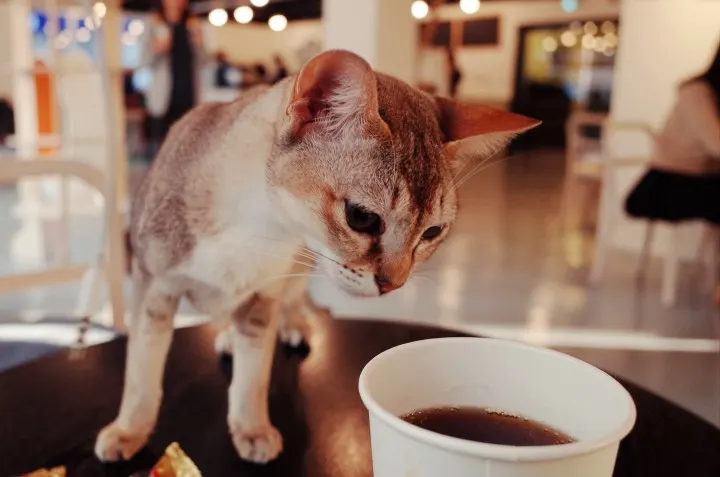
Cats And Taurine
The most important reason for this is that cats have an absolute need for the amino acid taurine.
Taurine is not available in human foods in adequate amounts to keep a cat healthy. A cat fed strictly human food will die.
Additionally, if a cat is fed too many treats, either human food or commercially made, it may be too full to eat adequate amounts of cat food to get its taurine needs met.
Cats are true carnivores, ideally getting more than 70% of their caloric intake from meat. Cats may eat grains, but they have no physiologic need for them.
Obesity
Other than taurine, a cat needs a balanced diet that is relatively high in protein and low in carbohydrates compared to the typical human diet.
Obesity is a huge (no pun intended) problem in domestic cats. A combination of commercial diets that are high in carbohydrates and a sedentary lifestyle has led to a population of very fat cats.
Obesity in cats leads to heart disease, arthritis, and diabetes mellitus. These health issues dramatically reduce the life spans of cats.
Cat Treat Tips
Cat treats can be a superb way to bond with your cat and work on your relationship.
There are many options when it comes to picking a treat for your cat. As discussed earlier, small bites of dairy products are an option. Other human foods, in small amounts, can be given as well.
If human food is used, it is essential to avoid any foods that can be toxic to cats, including grapes, raisins, chocolate, alcohol, and xylitol.
If a commercial treat from a pet supply store is more your style, there are many choices to choose from. The sheer number of treats on the shelf can be overwhelming.
A few things to ensure the best commercial treat for your cat:
- Look for a treat made by a pet food company you trust.
- Choose a treat that says “made in the USA.”
- The treat should claim to be all-natural
- Avoid preservatives
How Many Treats Are OK?
Treats for a cat should be used to reward good behavior, used for training, and employed as a way to bond with your cat.
The number of treats given to a cat should never exceed ten percent of the cat’s total dietary energy intake, though five percent is better.
An easy way to calculate this is to multiply the calories in each treat by the number of treats given. The cat’s daily calorie intake can be calculated from the food label on their food, or if you are not sure, contact your veterinarian.
Divide the daily total of calories by ten and make sure the total treat calories are less than this number.
Not only will too many treats lead to obesity, but many popular commercial treats and meats that many owners use as treats contain very high levels of protein. These high protein levels are much higher than appropriate for a cat’s daily dietary protein intake.
Human Food Treats for Obese Cats
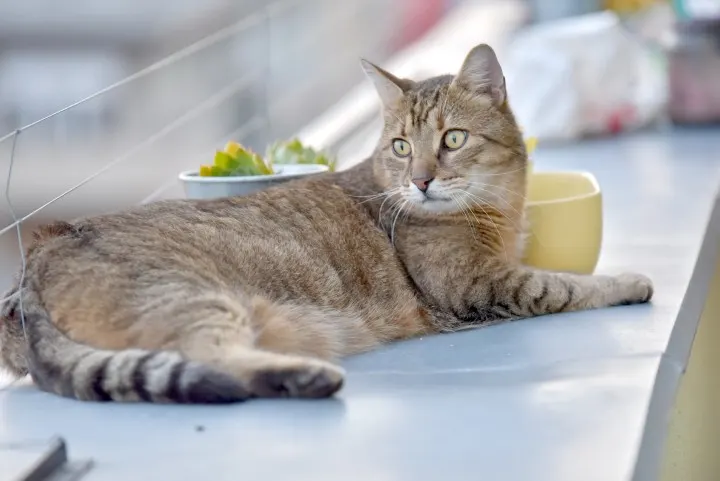 If your cat is already overweight or obese, it may seem impossible to give treats and still have the cat lose weight. However, some options can help.
If your cat is already overweight or obese, it may seem impossible to give treats and still have the cat lose weight. However, some options can help.
Many vegetables contain lots of water and high levels of fiber, which make great treats for an overweight cat.
If you are looking for a lean treat for your “fluffy’ kitty, try these:
- Green beans
- Broccoli
- Cauliflower
These are easy and cheap snacks to keep ready in your refrigerator that many cats really like! The added bonus is that they will give your cat a treat but, at the same time, not give them very many calories.
One of my favorite snacks for cats (and dogs) that are overweight is popcorn. It is straightforward- just throw some kernels into a paper lunch sack and pop them in the microwave.
Do not add butter, oil, or salt. The resulting snack is warm, crunchy, and pets love it! Popcorn is high in fiber and contains several healthy nutrients.
Air-popped popcorn is also very economical as a cat treat!
Homemade Cat Treats
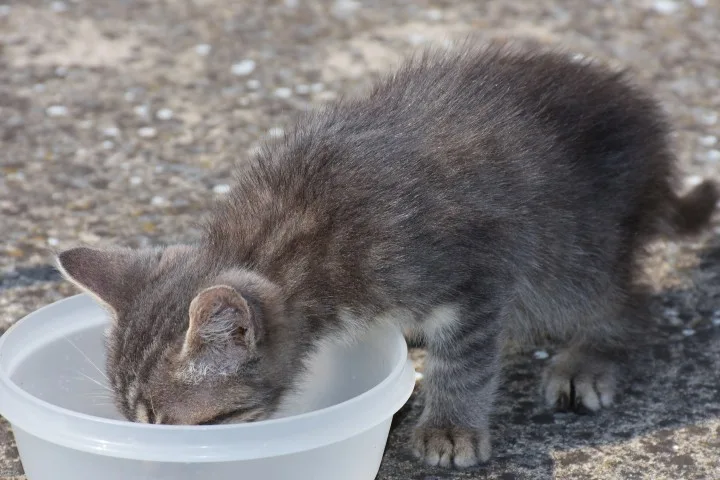 There is no better way to show your cat that you love them than to cook for them.
There is no better way to show your cat that you love them than to cook for them.
I do not recommend cooking their entire diet unless a veterinary nutritionist is consulted to design a complete and balanced diet for the cat. Without this, homemade diets are not nutritionally complete and can be dangerous to your cat’s health.
However, for treats, homemade cooking can be a great, fun way to make treats your cat will love! There are many recipes to be found on the internet, but I will include one I have used for my cat.
Because these treats do not contain preservatives, be sure to store them in the refrigerator or freezer to control any bacterial overgrowth that could make your kitty sick.
It is also easy to take canned food, section it into slices, make meatballs, or use small cookie cutters, and bake the shapes at 350 degrees for about 20 minutes, or until the treats are baked evenly.
This is a great option for kitties on prescription diets that are not allowed other foods.
Related Questions
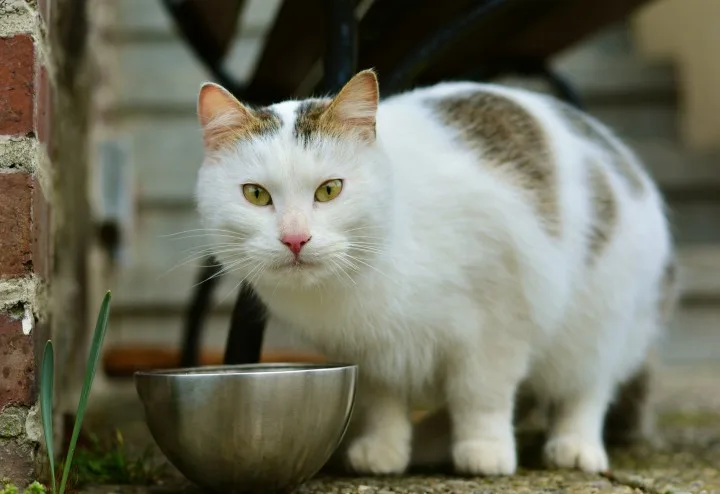 Is Cow Milk Bad for Kittens?
Is Cow Milk Bad for Kittens?
Kittens need their mother’s milk to receive all the necessary nutrients to grow. Cows milk is not an appropriate nor adequate milk replacement for kittens.
If a mother’s milk is unavailable, a commercial milk replacer like KMR should be used.
Can Cats Drink Lactose-Free Milk?
Yes, lactose-free milk contains, on average, 95-98% less lactose than normal milk. This type of milk can be a good alternative for cats but should still be given in small quantities and only as a treat.
Is Milk Good For Older Cats?
Older cats are even more prone to having delicate stomachs and gastrointestinal issues that milk may cause.
Older kitties need healthy diets that address their unique health concerns and milk’s high protein content may not be ideal for an older cat’s kidneys.
Our team is composed of pet care professionals, veterinarians, and pet owners. To date, we’ve conducted thousands of hours of research to publish the most accurate pet information.
Most of the writers on our site are vets with 10+ years of clinical experience, ranging from small practice, to equine practice, academia, and surgery. Our goal is to help every pet owner get the information they seek about their dear companions.

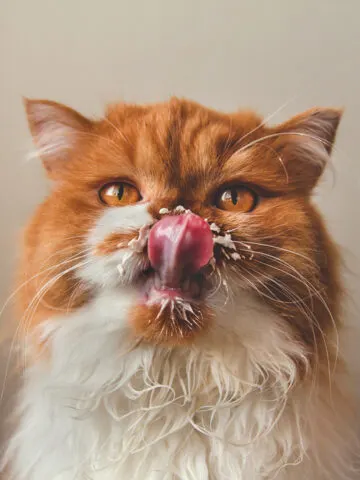

Leave a comment
You must be logged in to post a comment.